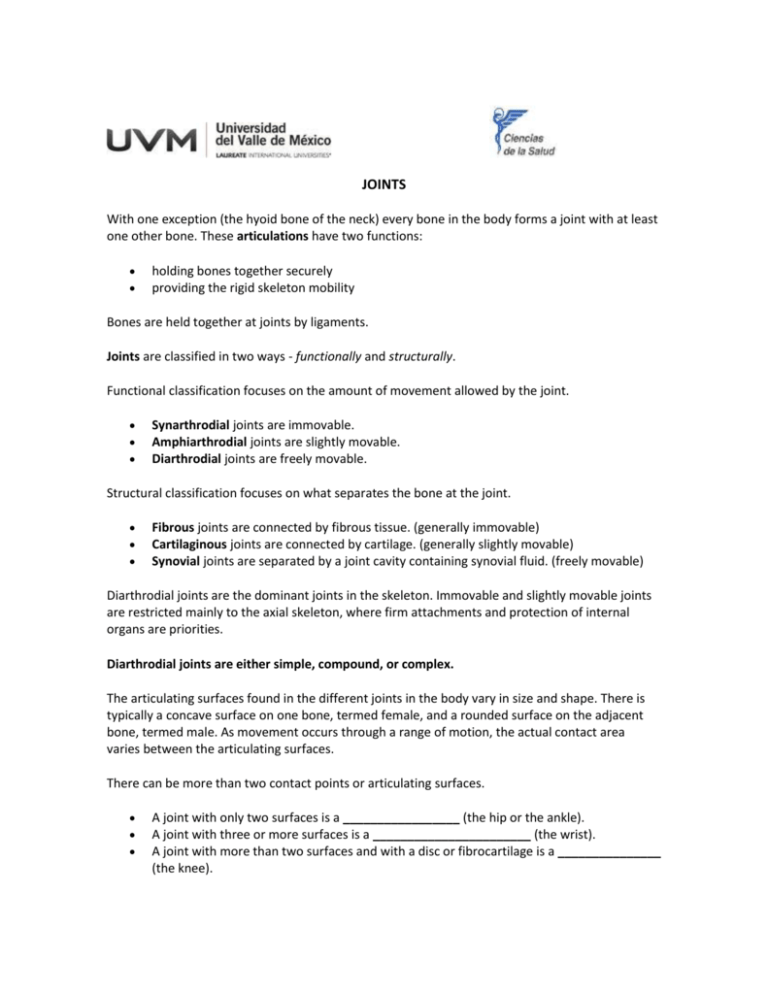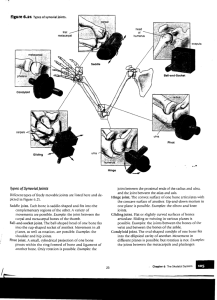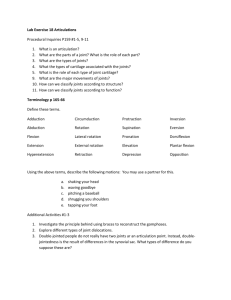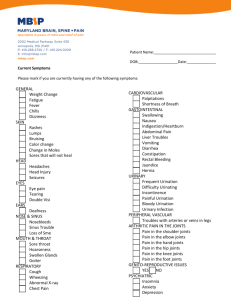Joints st's - inglestecnicouvm
advertisement

JOINTS With one exception (the hyoid bone of the neck) every bone in the body forms a joint with at least one other bone. These articulations have two functions: holding bones together securely providing the rigid skeleton mobility Bones are held together at joints by ligaments. Joints are classified in two ways - functionally and structurally. Functional classification focuses on the amount of movement allowed by the joint. Synarthrodial joints are immovable. Amphiarthrodial joints are slightly movable. Diarthrodial joints are freely movable. Structural classification focuses on what separates the bone at the joint. Fibrous joints are connected by fibrous tissue. (generally immovable) Cartilaginous joints are connected by cartilage. (generally slightly movable) Synovial joints are separated by a joint cavity containing synovial fluid. (freely movable) Diarthrodial joints are the dominant joints in the skeleton. Immovable and slightly movable joints are restricted mainly to the axial skeleton, where firm attachments and protection of internal organs are priorities. Diarthrodial joints are either simple, compound, or complex. The articulating surfaces found in the different joints in the body vary in size and shape. There is typically a concave surface on one bone, termed female, and a rounded surface on the adjacent bone, termed male. As movement occurs through a range of motion, the actual contact area varies between the articulating surfaces. There can be more than two contact points or articulating surfaces. A joint with only two surfaces is a _________________ (the hip or the ankle). A joint with three or more surfaces is a _______________________ (the wrist). A joint with more than two surfaces and with a disc or fibrocartilage is a _______________ (the knee). The Diarthrodial Joints: __________________: found in the foot between the tarsals and in the hand among the carpals. Movement at this type of joint does not occur about an axis and is termed non-axial since it consists of two flat surfaces that slide over each other to allow movement. In the hand, the carpals will slide over each other as the hand is moved to positions of flexion, extension, radial deviation, or ulnar deviation. In the foot, the tarsals shift during pronation and supination, sliding over each other in the process. _________________: allows movement in two planes (flexion, extension; abduction, adduction) and is biaxial. Examples of this joint can be found at the radiocarpal articulation at the wrist and the metacarpophalangeal articulation in the phalanges. ___________________: is similar to the ellipsoid joint in function, allowing two planes of motion (flexion, extension; abduction, adduction) with just a small amount of rotation. This joint is found only at the carpometacarpal articulation of the thumb. ______________________: allows movement in one plane (flexion, extension) and is termed uniaxial. Examples include the interphalangeal joints of the phalanges in the foot and hand, and the ulnohumeral articulation at the elbow. _____________________: also allows movement in one plane (rotation; pronation, supination) and is uniaxial. Pivot joints are located at the superior and inferior radioulnar joint and the C1/C2 articulation at the base of the skull. _________________________: allows primary movement in one plane (flexion, extension) with small amounts of movement in another plane (rotation). Examples are the knee and the temporomandibular joint. ________________________: the last type of diarthrodial joint, allowing movement in three planes (flexion, extension; abduction, adduction; rotation) and is the most mobile of the diarthrodial joints. The hip and shoulder joints are examples. __________________________________________: There are other articulations that are limited in movement characteristics but play an important role in stabilization of the skeletal system. Some bones are held together by fibrous articulations, such as those found in the sutures of the skull. These articulations, referred to as synarthrodial, allow little or no movement to occur between the bones and hold the bones firmly together. _________________________________: There are also cartilaginous joint, called amphiarthodial, that are bones held together by either hyaline cartilage, such as is found at the epiphyseal plates, or by fibrocartilage, found at the pubic symphysis and the intervertebral articulations. The movement at these articulations is also very limited, although not to the degree of the synarthodial joints. Joint Problems: ____________________ occurs when a bone is forced out of its normal position in the joint cavity. This results in damage to the ligaments or tendons reinforcing the joint by excessive stretching. ___________________ similar to a dislocation, with less stretching and damage. ___________________ is a general term describing over 100 different inflammatory or degenerative diseases that damage the joints. ______________________, the most common form of arthritis, is a chronic degenerative condition that typically affects the aged. ______________________, is a chronic inflammatory disorder. RA is an autoimmune disease - the body's immune system attempts to destroy its own tissues. ______________________, is a disease in which uric acid accumulates in the blood and may be deposited as needle-shaped crystals in the soft tissues of joints.





